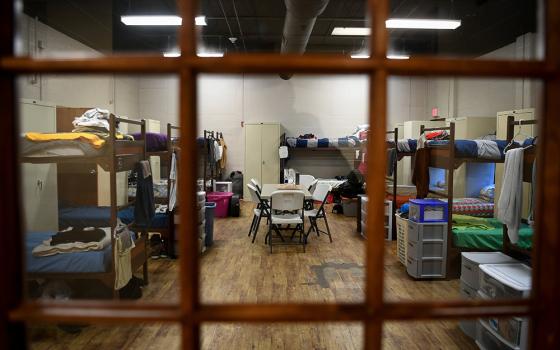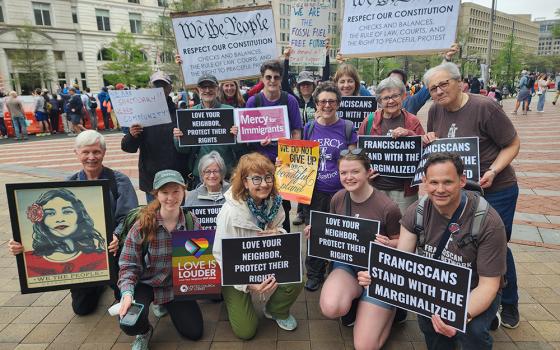
Capuchin Fr. John Pavlik was appointed on June 7 as the new executive director of the Conference of Major Superiors of Men, which brings together leaders of more than 200 men’s religious orders in the United States.
A native of Western Pennsylvania whose background is in formation and provincial leadership, Pavlik probably didn’t need convincing that his new gig is likely to be complicated -- but proof came anyway, in spades, just six days later.
On June 13, Pope Benedict XVI convened a rare “interdicasterial” summit, meaning a daylong working meeting of the heads of all the various Vatican offices. In the compartmentalized world of the Vatican, such communication across bureaucratic boundaries doesn’t happen very often -- so when it does, you know something big is up.
The theme of the session, as it turns out, was religious life. According to sources who took part in the meeting, topics included:
- The distinction between male and female orders, which is clear in canon law but sometimes less so in terms of the actual practice of community life.
- The distinction between religious life and the lay state, including insistence that laity who are in charge of a movement or association may not exercise formal ecclesiastical jurisdiction over priests and religious. Movements that include clergy and religious, such as Focolare or Sant’Egidio, must have a priest responsible for those members.
- The danger of emphasizing obedience to the founder of a religious order over obedience to the wider church and its teaching authority. Part of the subtext was the case of the Legionaries of Christ, which faced persistent criticism over the years for what some saw as a cult of personality around the founder, the late Mexican Fr. Marcial Maciel Degollado. Since the Legionaries have been forced to acknowledge that Maciel was guilty of a wide range of misconduct, including sexual abuse, the question is whether an exaggerated notion of authority inside the Legionaries helped to allow that misconduct to go unchallenged for so long.
The takeaway from the June 13 Vatican summit is that religious life -- its inner workings, its occasional dysfunction, and its Catholic identity -- is a top-shelf concern for officialdom these days, which means that Pavlik’s new role at the U.S. Conference of Major Superiors of Men becomes that much more important.
Pavlik, 61, sat down for an interview June 8 about the state of religious life today, as well as the role of the conference, whose mission is to promote the interests of the 20,000 religious priests and brothers of the United States (10 percent of whom are foreign missionaries) scattered across more than 200 communities.
* * *
What’s your vision of religious life in the early 21st century?
I’m passionate about religious life. I’ve grown to understand that the Holy Spirit is very much alive within the church, as Catholicism comes to a new way of relating to our 21st-century American society. Religious life has always been at the heart of the development of the American church, and that’s still true today. I’ve seen it, not simply from the perspective of the Capuchins. All you have to do is open your eyes in any diocese or region of the country, and you can see the contributions of women and men religious. ... We’re not here simply to wait for the last one to die to turn out the lights.
I believe religious life has vitality, but we also have to make a real commitment to it. We have to invite young people to know our charisms, and to allow them an expression which is real, not just historical. We need to consider how those charisms ought to be manifested, and we have to promote them in a way that’s sometimes bold, but which can also be reassuring to people looking for a connection -- not just with the institutional church, but with the reality of God in their lives.
Where do you see that happening?
One way in which I see it clearly is in the young people who really respond to effective evangelization. I do quite a bit of preaching around the country, and I see this firsthand. They’re longing for an awareness of God, for beauty, for a relationship with the wholly other. I don’t find young people inattentive at all. Sure, they have issues which have to be addressed, but there’s nothing new in that. ... I feel a responsibility to hand on something which is beautiful and wonderful, and which was given to me.
Religious are always out there, willing to serve in places which are out of the ordinary or difficult. My own province has a mission in Papua New Guinea, which is underdeveloped and where the conditions are fairly primitive, and it’s delightful to see people responding to the Lord there. Our brothers go there to serve people and to be there for the great good God has in mind. One of the glories of religious life is that we’re willing to do that sort of thing. It sometimes requires a courageous response, but I believe religious can do that.
For me, one joy of being a religious in leadership has come from the opportunity to collaborate with local churches in multiple dioceses. One observes the glories and the struggles of our Catholic communities, their successes and their incompleteness, their sufferings (sometimes over their inner sinfulness) and their unsung heroic works. With a spirit of collaboration, we bond with each local church where we serve and profess unity with its members, laity, fellow religious, and pastors, most especially with the local bishop, the chief pastor. ... Local churches and religious are mutually enriched, whether we have been invited to serve in that primary Catholic institution that is the parish or in an institution of higher learning or in a monastery which witnesses to a common life in Christ.
What do you see as the main challenges facing religious orders today?
Three come immediately to mind. First is to accept the cultural diversity of the contemporary church, to welcome it into our religious communities. That certainly includes ethnic diversity, but also other forms of cultural diversity taking place within American society. For example, the evolution of technology has a tremendous impact on how young people today are thinking and feeling. Let’s delight in that, see what’s good in it, and help them see how Christ becomes a part of that culture.
The second key issue for us is recruitment. We have to be looking for ways of finding the young people who can respond to this wonderful reality of religious life.
Third, we have to take care of our brothers who have served long and hard. ... We have to care for our brothers, provide a noble way for them to live out their final years. We need to continue to incorporate them in our communities, drawing on their wisdom. There’s also a challenge to find the financial resources to care for them in a way that honors them.
As executive director, you’ll also work closely with leaders in women’s religious life in the United States. What are your thoughts about the Vatican-sponsored apostolic visitation of women religious?
Here’s my fundamental belief about the whole process. When I think about all the seminary visitations and the like I’ve been involved in over the years, I can recall that with every one of them we worried about what might transpire. Yet in basically every case, regardless of whatever might have gotten them started, the experience itself was pastorally useful. They allowed us to reflect on how well we were living out what we had chosen to be. I suspect the same thing will be true of the visitation of women, that overall they’ll find it affirming.
When I look at our women, I see so many wonderful things that they’ve done in and for the church, not only throughout history but also in recent years. In the long run, I believe they’ll find themselves affirmed, with a new capacity to identify where God is leading them today. The women religious I’ve rubbed shoulders with initially were a little fearful, but there are some positive dimensions which are starting to become clearer. For one thing, I’ve heard a number of bishops go out of their way to affirm the women religious and to speak positively about them. From my perspective, good things can come of this experience.
How does the sexual abuse crisis affect religious life?
Because we religious are both professed and professional, we represent more than ourselves. We represent the whole church, as we live out another dimension of Catholicism in the common life of a religious institute. As such, we have an obligation to hold ourselves to the high standards we publicly promised, and to listen to the voices of those who observe us.
Every religious leader probably finds that Monday mornings bring to their desk both kudos for our fraternal witness, as well as critiques for our stumblings. I’m convinced that even our sorrow and embarrassments over our members’ sins, honestly owned, will lead us to a renewed or contemporary asceticism that serves its members because it responds to real, not idealized, situations. On the positive end, what a joy it has been for me when I hear someone praise the brothers because they offered something from the core of our common heritage.



